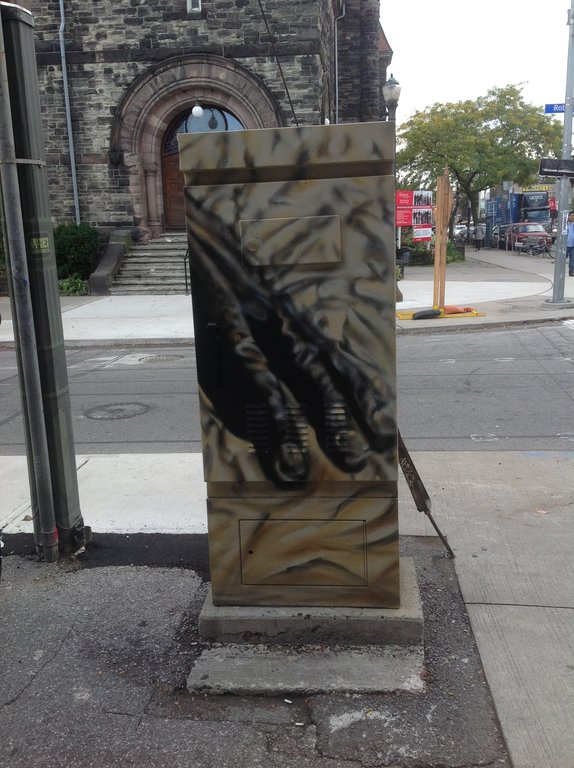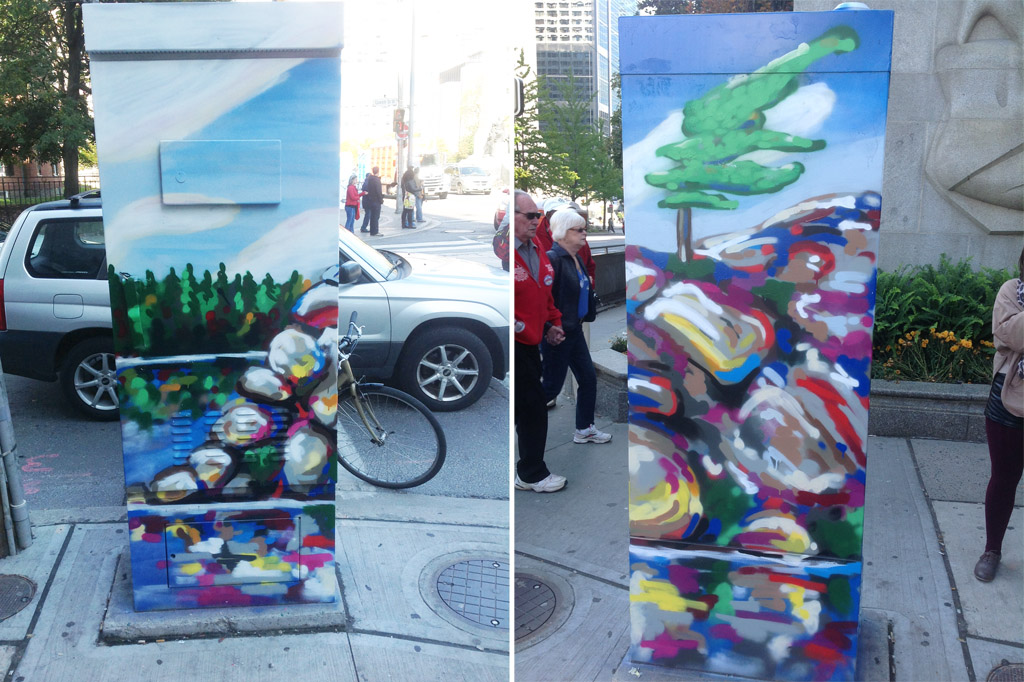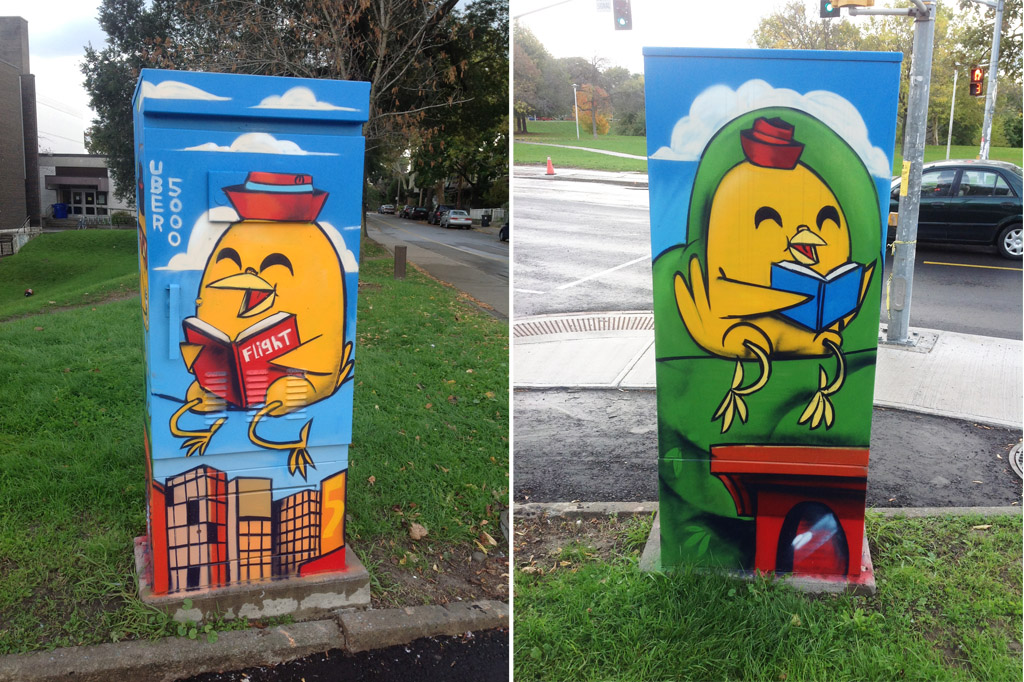On every signaled street intersection in Toronto, there is a large grey box. A transformer box where electricians can access the circuits that run the lights. In other words… a five sided, blank canvas.
 Susie Losee. Harris Water Treatment Plant, Queen Street East. Photo: Imre Hajagos
Susie Losee. Harris Water Treatment Plant, Queen Street East. Photo: Imre Hajagos
The Toronto City Council is currently undertaking an initiative that allows selected local artists to add some life to the boxes in an opportunity to expand on the city’s somewhat thriving street art culture. You may have even noticed a few already. Public art transcends its traditional habitat from the immaculate, temperature controlled gallery into the street to exist among us. It provides us with an opportunity to connect with art under our terms and in our environment. It is this connection that makes street art just for art’s sake. It becomes a symbol of the community and thus serves to bond us on innumerable various issues. It can also simply just provide us with a smile on our walk to work and help us forget just for a second how late we are. I began to think about the idea of art ‘existing among us’ and logged onto the councils publicly accessible archives to see whether this project is something anybody could get involved in. Are there benefits to be held in community collaboration?
 Productions Start by Adrian Hayles. Bloor Street and Robert Street corner. Photo: Rhys Male
Productions Start by Adrian Hayles. Bloor Street and Robert Street corner. Photo: Rhys Male
Lets take a look at the programs details to get acquainted with the principal idea of the initiative. In 2012 the Toronto City Council rolled out its new and amended, graffiti management plan. A key part of the plan is the traffic light box art project. 20 boxes across the city would be painted by 10 artists, selected by the city council. In addition, 100 ‘graffiti proof’ traffic box wraps will be installed around the city based on two designs. The cost of this project will exceed $85 000, including artists fees ($500 per box).
City council challenges the grumbling of the self appointed, armchair economists in our community who might feel that such a project is a waste of taxpayers money, and are usually as dull and grey as a traffic light box. I, on the other hand, admire their efforts in taking steps to further Toronto’s reputation as a forward looking, vibrant city. This in mind, it is disappointing to see the strict prerequisites one must hold to even be considered for an application. This is not to undermine the efforts of the skilled and talented artists that have been selected to take part. They of course deserve to be paid for their craft. This program however could potentially have a much further reaching social impact if it is more inclusive. Devon Ostom, Toronto based artist and curator notes that “Funds going to practicing artists is almost always a good thing…Lots of pro artists incorporate community input and processes so perhaps there is a middle ground there. However, it is going to be hard to get community input in there with a budget of only $500 each. Meaningful engagement processes take time and sometimes we just need to trust the artists.” ”
 Landscape. University and Dundas. Photo: Rhys Male
Landscape. University and Dundas. Photo: Rhys Male
I looked to other cities that have already implemented a similar program in search of the middle ground. In Brisbane, Australia, traffic light box art has been a council initiative since 1999. In correspondence with Genevieve Searle, Public Arts Officer, I learned that over a thousand boxes have been painted, and many of those, by members of the community who had submitted an application. She goes on to note that public participation in arts projects fosters a sense of individual and community identity, and it is something that public arts project managers hold in significant importance.
Encouraged to find out that community collaboration had already worked elsewhere in relation to the exact same project, I focused back on Toronto. Someone who knows the value of public participation in arts projects is the director of Artreach Toronto, Shahina Sayani. As the head of an initiative that aims to connect disadvantaged youths with their community through public art, I was excited to hear what she had to say about the project. Her response was very enthusiastic, “imagine what would come of this initiative if the artists that are commissioned to paint these structures were to share their artistry with community members and co-create. The impact would be tremendous; the art products would actually reflect the culture, diversity and flavour of the community they are situated within, and everyday citizens would feel more connected to their communities.”
 Yellow bird. Bloor Street and Montrose Avenue corner. Photo: Rhys Male
Yellow bird. Bloor Street and Montrose Avenue corner. Photo: Rhys Male
The beneficial reach of street art cannot be graphed, charted, or documented in such a way as to put a specific value on its worthiness. Nonetheless, those involved in the implementation process are aware that these benefits do exist. At the end of the day, the current program is a positive initiative. The platform has been built and publicly engaging works are now visible. However with evidence to support the inclusion of the community and over 2000 un-painted boxes, what should the next phase of this program be?
Rhys Male
